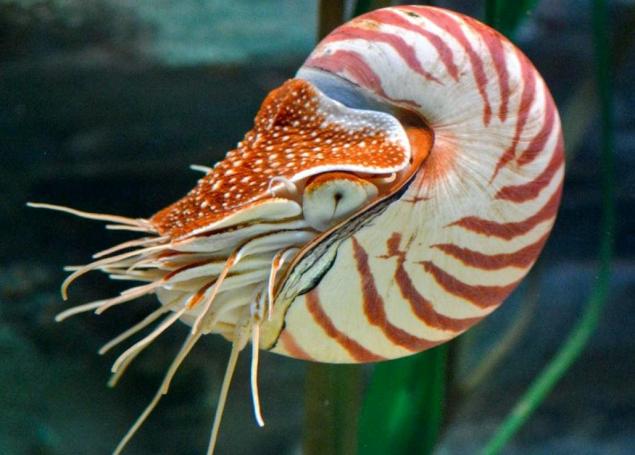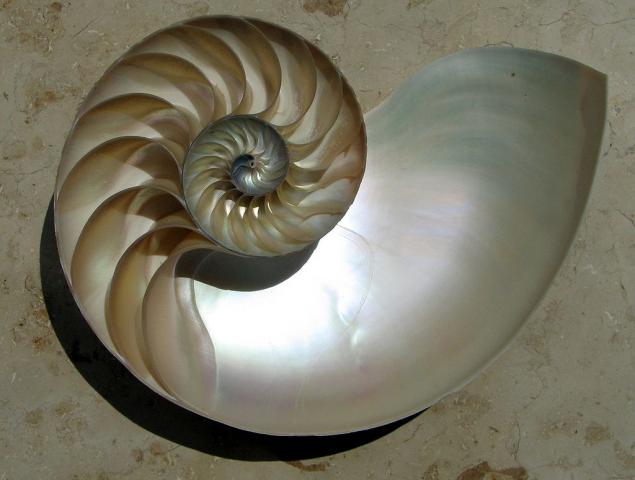938
Physics in the animal world: nautilus and "osmotic pump"

Source: youtube
Nautilus (Latin Nautilus.) - Genus of cephalopods, which are referred to as "living fossil." The most common type - Nautilus pompilius. Nautilus belong to a single genus modern Nautiloidea subclass. The first representatives Nautiloidea appeared in the Cambrian, and its development had to Paleozoic. Nautilids almost extinct at the boundary of the Triassic and Jurassic, but still survived to this day, unlike its relatives the ammonites. Some ancient nautilus reached a size of 3, 5 m. The representatives of the largest modern nautilus species reach a maximum size of 25 cm.
Modern nautiluses found in the Pacific and Indian Oceans. In some regions, they are numerous, but the range of their distribution is not too wide. Nautiluses Living at depths of 100-600 meters. These mollusks are constantly moving in the water, both vertically and horizontally, and for movement vertically nautiluses use osmosis - changing the concentration of salts in the cavities of his shell
Horizontal nautiluses move like cephalopods - using water jet ejection from the crater. The funnel turned the back of the leg, which is at all shellfish. The funnel is a conical tube that leads into the mantle cavity. It serves as a "motor" and the wheel. Speed of moving horizontally nautiluses frequency is controlled by the ejection of water from the funnel and changing its diameter. They sink swim forward, but if you want to grab prey, then turn to the victim "face".
Much more interesting mechanism vertically moving nautilus. Shellfish can easily adjust their buoyancy, becoming lighter or heavier than water, using the power of the osmotic pressure. Clamshell, except dwelling unit and several old cameras, filled with liquid, the composition of which differs from the seawater. In particular, the salt concentration in this liquid is lower than that of sea water. Several chambers are filled with a biological gas that is produced in the process of life nautilus.
In order to better understand the mechanism of movement of the Nautilus, it is worth considering the structure of its shell. All kinds of spiral nautilus shell, strongly twisted. mollusk's body is located always at the latest, the biggest chamber. The rest of the camera work like a hydrostatic system. The partitions shells have openings through which passes a thin tube called a siphon. This tube is connected to the rear part of the body nautilus.

nautilus sectional. Siphon is not visible because it is composed of soft tissue, which is not in the sink in the image (Source: Wikipedia)
If necessary nautilus emerge, it becomes easier due to pumping out the water from the fluid by the siphon monovalent ions. It mainly, Na + and Cl-. Adjusting the concentration of monovalent ions is performed using a special enzyme - Na-K-ATPase. The hormone is produced and accumulates in epithelial tissue of the siphon. First, ions are pumped out of the fluid chamber, and then enter the trap, and then - in the blood. There osmotic pressure, water with a low salt concentration enters the siphon and then through a kidney - the environment. In some clamshell vacuum chamber is formed, they are filled with gas, sink becomes easier, and the nautilus floats.

This photo siphon can be seen very well (source: discoveringfossils.co.uk)
If necessary plunge nautilus, ions from the blood under the influence of Na-K-ATPase enter the shell fluid. Osmotic pressure causes that collects water sink, the sink chamber gradually filled, and the animal with sink becomes heavier than water, which allows Nautilus dive. Maximum diving depth - about 700 meters, which corresponds to 70 atmospheres. It is able to withstand the pressure of a nautilus shell. Go deeper, the animal simply dies.
Nautilus can adjust its buoyancy so as to hang motionless in the water column. The center of buoyancy at the Nautilus does not coincide with the center of gravity, being a few centimeters higher. This ensures vertical stability mollusc. When hovering in the water can be seen as nautilus swinging with a certain amplitude. This is due to the fact that shellfish breathing draws water into the sink. When "exhale" water jet gives rise back shell deviates from the original position. At the "inspiration" clam returns to its original position.
In nautilus, there is another interesting feature - their eyes lack lenses and cornea. The pupil in their eye - a common hole through which the light falls directly on the retina. No shell in this eye is not present, the pupil and the eye cavity is filled with water. Japanese researchers studied the gene nautilus, and found that this mollusk is not Six3 / 6 gene. It is an ancient gene, which have virtually all animals, from shellfish to humans. It is responsible for the formation of the lens and the cornea. Perhaps ancestors nautilus for some reason lost the gene during evolution. There is also a suggestion that a nautilus eye is a transitional form between the primitive and complex light-sensitive eye to eye lens and the cornea.
Source: geektimes.ru/post/279138/
The owner of the bar in England established the Faraday cage to block cellular communication in the institution
Face masks of peaches - regal beauty recipes























